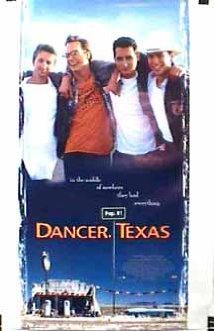“Leaving the Nest”

| None | Light | Moderate | Heavy | |
|---|---|---|---|---|
| Language | ||||
| Violence | ||||
| Sex | ||||
| Nudity |
Content:
(H, B, L, S, A) Mild secular humanist worldview with moral elements; 3 obscenities; implied sexuality in one scene; and, beer drinking & alcoholism implied.
More Detail:
DANCER, TEXAS POP. 81 is a relatively clean, PG-rated drama that depicts small-town-life for a group of four young men who are trying to decide what to do with the rest of their lives. It is a warm-hearted but secular movie with moments of quiet beauty.
The four young men made a vow at age 11 that they would move from their small Texas town to Los Angeles upon high school graduation. The movie opens with the four boys sitting on a highway in lawn chairs discussing a letter to Rand McNally, the map-making company, urging company officials to put Dancer on the map. We meet Keller (Breckin Meyer), Terrell Lee (Peter Facinelli), Squirrel (Ethan Embry), and John (Eddie Mills). Each one comes from vastly different backgrounds and has very different reasons for wanting to leave.
Leaving a small town apparently isn’t easy — a point that is emphasized throughout the movie. For instance, the cynical townsfolk immediately begin placing bets on how many will actually leave Monday morning following graduation, which is less than 48 hours away.
Keller takes the lead in making the move. His room is decorated with icons of LA and he has been reading about it and budgeting for it for years. Keller’s parents have died, and he takes care of his elderly grandfather, who never changes his chair or his clothes during the movie.
Terrell Lee comes from a wealthy oil family. His mother bullies him to stay and learn the family business. Consequently, Terrell is indecisive, a trait that is illustrated by the fact that he has two girlfriends.
Squirrel, the third boy, would be the class geek, but his class only has five members. His antisocial ways are defined by living in a beat-up, off-balanced motor home with his inconsistent alcoholic father on the floor and a woman in father’s bed.
John comes from a nice ranching family and is a born rancher, so it seems. Though he ably handles horses, he feels his father doesn’t want him to stay.
Each boy has issues to resolve before he goes, which the movies treats nicely. We like and care about each boy’s fears and dreams, and the movie’s ending warms our hearts. None of the actors in DANCER, TEXAS are big names or recognizable faces, and their anonymity adds credibility to the small town story. These are actors with a future as each gives a credible, nuanced performance, particularly Breckin Meyer. It is hard to believe that leaving a small town is akin to sailing the Pacific in the fifteenth century, but that is what the movie says.
While low-budget, the movie’s cinematography is beautiful and was actually filmed in the small Texas town of Fort Davis. The direction, clean and simple, defines the quiet beauty of the small town.
Any movie that the New York Times describes as too wholesome for its own good has something going for it. Except for a few obscenities and an implication that Squirrel’s father is an alcoholic womanizer, objectionable elements in DANCER, TEXAS are nearly as vacant as the town itself. Ultimately, the movie suggests that change is inevitable, even if it seems to take decades. Director Tim McCanlies does a Larry McMurtry-esque job of illustrating how people are somehow part of a place and how a piece of land can come to define a people.


 - Content:
- Content: 





